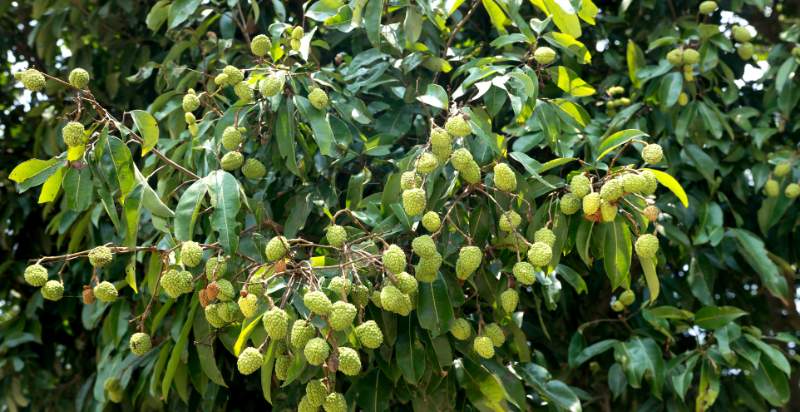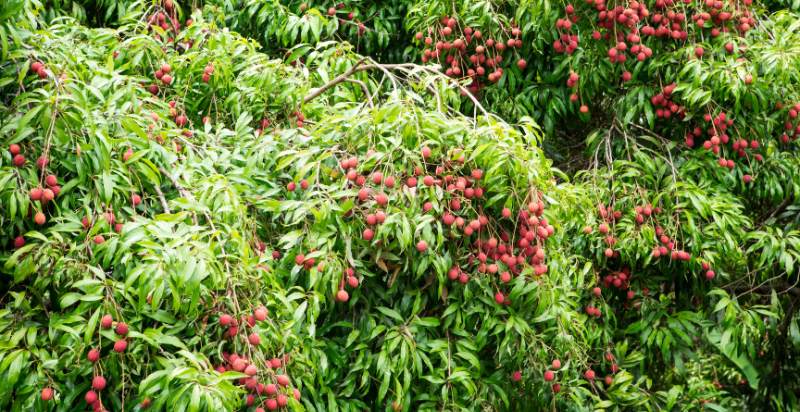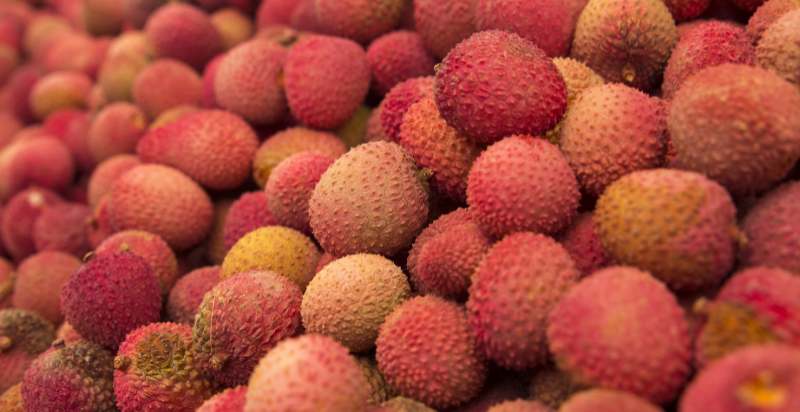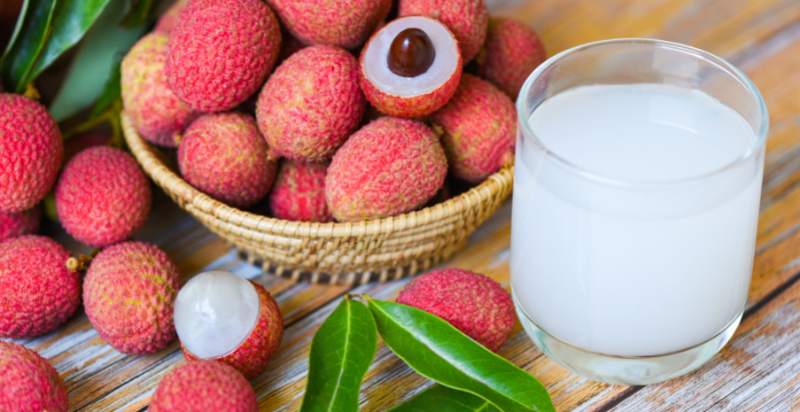Lychee, or Litchi chinensis, is a tropical fruit native to Southern China and Southeast Asia. It is a small, round fruit with an outer layer that is thin and leathery. The pinkish-red skin covers sweet white flesh with a texture like that of grapes. Lychees have been cultivated in China for over 2,000 years and are an important crop in many parts of Asia. Here’s everything you need to know about lychees.
What is Lychee?
Lychee is a small, round tropical fruit that grows on an evergreen tree. Its thin pinkish-red skin covers sweet white flesh with a texture like that of grapes. The flavor of the fruit is reminiscent of a sweet grapefruit or strawberry. Lychees are typically eaten fresh but can also be found in canned, dried, and frozen forms.
History and Origin of Lychee:
The lychee is native to Southern China, where it has been cultivated for centuries. It was first introduced to the West in the early 1800s and quickly gained popularity due to its sweet flavor and attractive appearance. The fruit has been widely cultivated throughout southern Asia and parts of South America since then.
Lychees are a member of the soapberry family, and they have a unique sweet-tart flavor that makes them popular among many cultures. The fruit is also high in vitamin C and antioxidants, making it a healthy snack. Lychees are often fresh but can also be used to make juices, jams, desserts, and other dishes. The popularity of lychee has grown around the world thanks to its tasty flavor and versatility in the kitchen.
Over the years, Lychee cultivation has become increasingly complex as growers strive to produce higher yields and better-quality fruits. In addition to traditional farming practices such as pruning and fertilizing, modern farmers use sophisticated growing methods like grafting and irrigation systems to maximize their crop potential. The labor-intensive process of delicate harvesting fruits is also important in lychee production. With its long history and a culture deeply rooted in tradition, lychees remain a beloved fruit worldwide.
Lychee cultivation has been so successful that it’s now considered one of the most significant crops in many parts of Asia. In China, for example, the fruit is often given as gifts during special occasions like weddings or holidays. It’s also become an important export crop, with countries like Thailand and India exporting large quantities yearly to global markets. The popularity of lychee continues to grow, and more people than ever are discovering this delicious fruit every day.
Varieties of Lychees:
Wide varieties of Lychee are available worldwide, each with unique characteristics. The most popular variety is the ‘Hainan’ lychee, which has thin, light-colored skin and a sweet flavor. Other common varieties include the ‘Longan,’ ‘Bang Bua Thong,’ and ‘Makok.’ The Longan variety is known for its distinctively sweet taste; Bang Bua Thong is larger, with thick skin and sweeter flesh; and Makok is smaller but still packed with flavor.
Depending on where you live, you may also find other exotic varieties such as Litchi chinensis var. carnosa (also known as the “Red Rambutan”), Litchi chinensis var. caerulea (the “Blue Rambutan”), and Litchi chinensis var. cumini (the “Black Lychee”). These varieties have unique characteristics, such as different-sized fruits, pulp colors, sugar content, flavor profiles, and more.
No matter what variety you choose to enjoy, one thing is for sure – lychees are a delicious treat! Enjoy them fresh or dried, or use them in recipes from salads to desserts. Their sweet flavor adds a special touch to any dish.
Nutritional Value of Lychee:
Lychee is a sweet and juicy fruit packed with essential vitamins and minerals. Lychee contains significant amounts of vitamin C, folate, copper, magnesium, manganese, and dietary fiber. This makes it an excellent addition to any balanced diet.
The high antioxidant content of lychees also helps protect against inflammation-related diseases such as cancer, heart disease, and diabetes. The flavonoids in this fruit are known to reduce the risk of certain types of cancers as well. Furthermore, the fiber found in lychee can help regulate blood sugar levels while promoting good digestive health.
One cup of fresh lychee contains approximately:
- 64 calories
- 16 grams of carbohydrates
- 0.8 gram of protein
- 0.5 gram of fat
- 2.6 grams of dietary fiber
- 52 milligrams of vitamin C (87% DV)
- 9 micrograms of folate (2% DV)
- 0.1-milligram copper (3% DV)
- 27 milligrams magnesium (7% DV)
- 0.3 milligrams of manganese (14%)
Overall, lychee is an excellent source of vital nutrients and can help to support a healthy diet. It is important to note that while the nutritional content may be beneficial, eating too much lychee can lead to weight gain due to its high calorie and carbohydrate content. Therefore, it is important to consume this fruit in moderation.
The Health Benefits of Lychee:
Lychee is a tropical fruit that has many health benefits. It is rich in antioxidants and vitamins such as vitamin C, which can help boost the immune system. Lychees also contain polyphenols, which are beneficial for cardiovascular health. The electrolytes in lychees can help prevent dehydration and provide energy for physical activities. Additionally, the dietary fiber content in lychees helps to keep you full longer so that you eat less throughout the day.
The phytonutrients in lychees have anti-inflammatory properties that may reduce your risk of cardiovascular disease and cancer. In addition, lychee contains ellagic acid, an antioxidant compound that may protect against age-related diseases like Alzheimer’s. Lychee also has anti-bacterial and antiviral properties, which can help fight off colds and other illnesses.
Finally, lychee is low in calories yet contains many important nutrients beneficial for overall health, such as dietary fiber, vitamins, minerals, and antioxidants. Eating just a few pieces of lychee can significantly benefit your health. So next time you’re looking for a healthy snack, consider adding some lychees to your diet!
What are the Uses of Lychee?
Lychee is a sweet and juicy fruit that has many uses. It can be eaten fresh, cooked, or dried. Lychee juice is also popular in drinks and desserts like ice cream, smoothies, juices, and cocktails. Lychees are also widely used in Southeast Asian cooking as a flavoring for both savory and sweet dishes. In addition to its culinary uses, lychees have been known to boost immunity, lower cholesterol levels, aid digestion, and improve heart health. Lychees are also sometimes used medicinally to treat coughs and colds, reduce inflammation, improve skin conditions, treat insomnia, decrease blood pressure, and even fight cancer. With all these benefits, it’s no wonder that lychee is quickly becoming a popular addition to many people’s diets.
Lychees are also used in beauty products such as soaps, creams, and lotions. The fruit oil has anti-aging benefits and antioxidant properties, which help protect skin cells from damage caused by free radicals. Lychee extract can also be found in some facial masks and serums, which help nourish the skin and promote cellular regeneration. In addition, lychee essential oils can be added to aromatherapy treatments to reduce stress and anxiety levels while increasing feelings of tranquility and relaxation.
Finally, lychees are sometimes made into jams, jellies, or preserves for baking or as a topping for toast, pancakes, waffles, and other breakfast foods. The sweet taste of lychee makes it a popular choice among many home cooks and bakers.
With its abundance of uses, it’s no wonder lychee is quickly becoming one of the most popular fruits. Whether you are looking to add flavor to your cooking, reap the health benefits, or incorporate it into your beauty routine, lychees are an easy way to do so!

How to Plant Lychee?
Lychee is a tropical fruit native to southern Asia and widely grown worldwide. It has a sweet, juicy flesh that can be used in desserts or eaten fresh. Although lychee tree require special care, they are relatively easy to maintain for those who want to grow their fruits at home. Here’s everything you need to know about planting your lychees.
Choosing Lychee Trees
When breeding at home, it’s best to choose young grafted plants rather than seedlings, as these will bear fruit much sooner and with more assurance of success. Look for trees labeled ‘dwarf’ varieties, which take up less space and are easier to care for.
Preparing the Soil
Lychee tree prefers a pH of 5.5-7.0 and will do best in well-draining, sandy loam soil high in organic matter. If you’re unsure of your soil type or pH level, consider testing it before planting lychee trees. Adding compost to the planting site will help boost fertility and provide plenty of nutrients for your trees.
Planting Lychee Trees
When planting, be sure to dig a hole at least twice as wide and deep as the tree’s root ball. Place the tree into the hole with the root ball slightly above ground level and fill any open spaces with soil. Gently press down the soil around the tree’s roots to ensure good contact with the ground and water.
Maintaining Lychee Trees
Once planted, lychee tree need regular water but should be kept from being overwatered or allowed to become waterlogged. Fertilize your trees regularly using a balanced fertilizer to ensure they get all the necessary nutrients. Depending on your climate, you may also want to protect young trees from extreme temperatures by providing shade and pruning them as needed.
Harvesting Lychees
It takes three to five years for lychee plants to produce fruit, so patience is key. When the fruits turn bright red and feel firm, it’s time to harvest. Remove the fruit from the tree and enjoy.
Lychee tree is wonderful additions to any garden or backyard and can provide countless delicious fruits year after year. With effort and dedication, you’ll soon be enjoying fresh lychees straight from your trees.

How to Care for and Grow Lychee?
- Choose a planting spot – Lychees prefer sunny, well-drained soils with a pH of 6–7. Avoid areas that are prone to flooding or standing water.
- Plant your lychee tree – Purchase a semi-dwarf grafted variety adapted to your area and plant in late winter or early spring for the best results. Plant the root ball at least one foot deep and eight feet away from other trees and buildings.
- Water regularly – Once established, water your lychee tree every 5–14 days during hot weather, depending on local conditions and soil type. During cooler weather, reduce watering frequency but avoid letting the soil dry out completely between irrigations. Note: Lychees are drought-tolerant, but too much dryness can reduce fruit quality.
- Feed your lychee tree – All young fruit trees need fertilizer to grow and thrive. When the weather has warmed up in early spring, apply a balanced fertilizer such as 10-10-10 or 12-6-6 around the root zone.
- Prune in late winter – To keep your lychee healthy and productive, prune out any dead or damaged branches every year in late winter just before new growth begins. This will also help control size if you have limited space and don’t want it to get too big.
- Protect from pests – Lychees can attract pests like aphids and scale. Regularly check your tree for signs of infestations, and treat any pests you find with an appropriate pesticide.
- Harvest – Lychee trees typically begin to bear fruit 3–5 years after planting, but this can vary depending on the variety and conditions. You’ll know when lychees are ripe because they turn a deep red color, although some varieties may range from pink to yellow or tan when mature. Pick these fruits when they reach their peak sweetness and enjoy!
- Enjoy the bounty – Lychees can be eaten fresh off the tree or used in recipes such as salads, jams and jellies, ice cream, smoothies, and more! If you have an abundance of fruit, you can also freeze the peeled fruits to enjoy later.
With a little care and attention, your lychee tree will produce delicious fruits for many years to come!

Preventions from Pests and Diseases of Lychee?
- Know Your Enemy: It is important to be aware of the pests and diseases that may affect your lychee tree, as this will help you identify problems early and take necessary action. Common pests include aphids, scales, mealybugs, and spider mites; common diseases include anthracnose, black spot, powdery mildew, and root rot.
- Healthy Soil & Nutrients: Healthy soil helps keep your lychee tree healthy – ensuring it has enough nutrition by regularly checking its pH level and supplementing with fertilizer when needed can reduce the chances of disease or pest infestations. Regularly adding organic matter to the soil can also provide essential nutrients for optimal growth.
- Pruning: Regular pruning is important for lychee trees to keep them in the desired shape and size and encourage new growth. Pruning also helps reduce pest infestations by removing dead wood, which can become a breeding ground for pests.
- Keep it Clean: Taking care of your tree by removing fallen leaves, fruit, and dead branches will help keep pests away and prevent diseases from spreading.
- Watering & Mulching: Giving your tree enough water is essential for its health; however, over-watering should be avoided to reduce the chance of root rot. Adding mulch around the tree’s base will help retain moisture in the soil and prevent weeds from growing.
- Protect Your Tree: Keeping a close eye on your lychee tree is important, as any signs of pests or diseases should be dealt with quickly before they can spread and damage the tree. If necessary, spraying with pesticides can help reduce pest infestations; however, only use chemicals as a last resort.
- Monitor for Disease & Pests: Regularly inspect your lychee tree for symptoms of disease or pests, such as discolored leaves, holes in fruit, and other irregularities. Taking action immediately when you spot an issue will prevent further damage to the tree and ensure optimal health.
By following these steps, you can help protect your lychee tree from pests and diseases and ensure it remains healthy for many years. With a bit of care and attention, you will be able to enjoy the delicious fruits of your labor for a long time.
How to use How to harvest Homegrown Lychee?
- When to Harvest Lychee: Harvesting your homegrown lychees is a very exciting and rewarding experience, but it can take some work to get the timing right. Generally, most fresh lychees are ready for harvesting in late spring or early summer when their skin turns green to light pink or red.
- How to Determine Ripeness: To ensure that your crop of lychees is ripe and ready for harvest, examine the fruits closely. If they feel hard and have lightly colored but bright outer skin, then they’re ready for picking. You should also look out for a sweet smell from the fruit — this is a sure sign that it’s fully ripened and ready to be harvested.
- Harvesting Tips: When harvesting your homegrown lychees, you mustn’t pull too hard — this can cause the fruit to break apart or even damage the branch from which it is growing. Instead, use a pair of gardening shears or scissors to snip off the branch where the fruit is attached. This will ensure that the lychee remains intact and ready for eating!
- Storing Your Lychees: After successfully harvesting and collecting your fresh lychees, it’s important to store them correctly to keep them in prime condition for eating. Place your fruits into a container with plenty of space and make sure to keep them in a cool, dark place. You can also freeze lychees for up to 6 months, though this will affect the flavor somewhat.
- Enjoying Your Fruits: Once you’ve harvested, stored, and prepared your homegrown lychees, it’s time to enjoy their sweet and juicy flavor! Lychees are perfectly eaten fresh but can also be used in smoothies or salads. If you want to get creative, why not try using them as an ingredient in cakes or other desserts? There is no limit to how you can use lychees.

How to Store Homegrown Lychee?
- Make sure you harvest lychee when it is ripe. You can do this by gently squeezing the fruit; if it gives a little, it’s ripe. If it’s hard, leave it on the tree for a few more days and check back regularly until you find some ready to pick.
- Gently remove any leaves or stems from the fruit before placing them in an airtight container or basket lined with paper towels to prevent moisture buildup. You can set aside the stem and store it separately for later use in tea or other recipes.
- Place the containers of lychee in the refrigerator and store them for up to four weeks at temperatures between 33 degrees and 40 degrees Fahrenheit (1-4 degrees Celsius).
- Alternatively, you can freeze the lychee for up to six months at 0 degrees Fahrenheit (-18 degrees Celsius). To do this, you’ll want to layer the fruits in a shallow container, ensuring they don’t touch each other, then cover it with plastic wrap and place it in the freezer.
- If you prefer to preserve lychee without refrigeration or freezing them, try candying them. Simply mix one cup of granulated sugar with one cup of water and bring it to a boil over medium heat until all of the sugar has dissolved. Then add 1/2 teaspoon lemon juice and drop in your washed and peeled lychee. Boil for about 20 minutes, occasionally stirring until the syrup has thickened and the lychee is cooked through. Let cool before storing in an airtight container. Candied lychee can last up to two months in a cool, dry environment like a pantry or cupboard.
- You can also dry lychee by slicing them thinly and dehydrating them in a food dehydrator at 140 degrees Fahrenheit (60 degrees Celsius) for five to six hours. Dried lychee will keep for several months if properly sealed and stored in an airtight container away from direct sunlight.
- Lastly, you can preserve your homegrown lychee by making jam or jelly! The process is similar to making traditional jam or jelly, but you’ll need to add enough sugar and pectin to thicken the mixture. Store in jars or containers and keep it in the fridge for up to two months.
No matter how you store lychee, ensure that you remove any overripe before storing them, as they can spoil quickly and contaminate the rest of your fruits.

How to Store Homegrown Lychee in your day-to-day life?
The best way to store homegrown lychee is by refrigerating them. To do this, start by washing your lychees with cold water and drying them completely. Place the lychees in an airtight container or plastic bag and then put them into the fridge, ensuring they are not touching or stacked on top of one another. This will help keep them fresh for up to two weeks. You can also freeze lychees if you plan on storing them for longer periods; make sure to thaw them thoroughly before eating them.
If you’d prefer not to store your lychees in the refrigerator, a few alternative methods may work better for you. For instance, you can keep them at room temperature on a flat surface in areas not exposed to direct sunlight, such as in a cupboard or pantry. This method should help maintain the freshness of your lychees for up to two weeks. You can also store them in a brown paper bag with holes punched in it for ventilation; this will help absorb any moisture and keep the lychees from spoiling too quickly.
No matter which storage option you choose, inspect your lychees regularly and discard any that appear spoiled or moldy. Lychees are delicate fruits, so proper care and attention must be taken when storing them!

Potential Risks from Lychee in your day-to-day life:
It is recommended that you consume only moderate amounts of lychee to minimize any potential risks associated with it. Additionally, you should be sure to speak with your doctor before consuming lychee if you have any health issues.
In addition to the potential health risks associated with lychee consumption, other aspects of this fruit can be dangerous if not handled properly. For instance, unripe lychees contain hypoglycins A and B, which can cause a life-threatening condition called acute toxic encephalopathy when too much is consumed. To avoid this risk, you must ensure all of the lychees you consume are fully ripe. Finally, the skin and seeds of lychees are believed to be poisonous, so these should never be consumed.
Overall, consuming moderate amounts of lychee can have health benefits and provide you with essential vitamins and minerals. However, it’s important to be aware of the potential risks associated with eating too much of this fruit to ensure your safety. Be sure to speak with your doctor if you have any concerns about adding lychees to your diet.
Conclusion:
In conclusion, lychee is a sweet and delicious fruit that can be enjoyed as part of a healthy diet. It’s important to be aware of the potential risks of consuming too much lychee, including kidney stones, gallbladder issues, weight gain, diabetes, heart disease, and stroke. Additionally, unripe lychees contain toxins, and the skin and seeds should never be consumed. Follow proper storage techniques to ensure your homegrown lychees stay fresh for up to two weeks – refrigeration or storing them in a cool dark area works best – and practice moderation when adding lychee into your day-to-day life. If you have concerns about incorporating this fruit into your diet, you should speak with your doctor. Enjoy the taste of lychee responsibly!
- Everything you wanted to know about Green Tiger Tomatoes. - April 1, 2024
- Everything you wanted to know about Atomic Grape Tomatoes . - April 1, 2024
- Plum Types and Varieties: A Comprehensive Overview | GardenersMag . - April 1, 2024

2 thoughts on “What is Lychee? How to Plant, Grow, and Harvest Lychee”
Comments are closed.